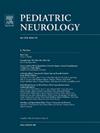General Movements as Predictive Tool of Neurological Outcomes in Term-Born Infants With Hypoxic-Ischemic Encephalopathy at Ages Six and 12 Months
IF 3.2
3区 医学
Q2 CLINICAL NEUROLOGY
引用次数: 0
Abstract
Background
To explore the utility of general movements assessment as a predictive tool of the neurological outcome in term-born infants with hypoxic-ischemic encephalopathy (HIE) at ages six and 12 months.
Methods
This prospective observational study was conducted for 18 months (August 2018 to December 2019). Term-born newborns with HIE were included. General movements videos were recorded at 10 to 14 weeks (50 to 54 weeks postmenstrual age) and assessed. Further development was assessed with Developmental Assessment Scales for Indian Infants (DASII) and Ages and Stages Questionnaire, third edition, (ASQ-3) at ages six and 12 months.
Results
A total of 30 children were enrolled, 19 (63%) had normal fidgety movements (FMs) and 11 (37%) had absent FMs. Motor Optimality Score, Revised, (MOS-R) ranged from 6 to 8 in 11 infants with absent FMs. Among them, one had mild developmental delay (DD), two had moderate DD, and eight had severe DD on the DASII assessments (P < 0.001). Sensitivity between absent FMs and ASQ-3 developmental scales showed that the majority with absent FMs had severe DD. Absent FMs had 81.8% sensitivity and 89.4% specificity for detecting cerebral palsy (CP) (n = 11).
Conclusions
The assessment of the FMs has a very good predictive value for future neurodevelopmental outcomes. MOS-R can provide a fair estimate of the functional ability of infants who later develop CP, and better MOS-R scores correlate with better outcomes. Children with absent FMs had significantly lower median motor and mental developmental quotients as calculated by DASII at both ages six and 12 months.
一般运动作为6个月和12个月低氧缺血性脑病足月婴儿神经预后的预测工具。
背景:探讨一般运动评估作为6个月和12个月低氧缺血性脑病(HIE)足月婴儿神经预后预测工具的实用性。方法:本前瞻性观察研究为期18个月(2018年8月至2019年12月)。包括患有HIE的足月新生儿。在月经后10至14周(50至54周)记录一般运动视频并进行评估。在6个月和12个月时使用印度婴儿发育评估量表(DASII)和第三版年龄和阶段问卷(ASQ-3)评估进一步的发育。结果:共纳入30例患儿,其中19例(63%)有正常的躁动(FMs), 11例(37%)无躁动(FMs)。运动优化评分,修订,(MOS-R)范围从6到8在11名婴儿没有FMs。其中轻度发育迟缓(DD) 1例,中度发育迟缓2例,重度发育迟缓8例(P)。结论:FMs的评估对未来神经发育结局有很好的预测价值。MOS-R可以为日后发展为CP的婴儿的功能能力提供一个公平的估计,更好的MOS-R评分与更好的结果相关。根据DASII计算,在6个月和12个月时,FMs缺失的儿童的运动和智力发展商数中值明显较低。
本文章由计算机程序翻译,如有差异,请以英文原文为准。
求助全文
约1分钟内获得全文
求助全文
来源期刊

Pediatric neurology
医学-临床神经学
CiteScore
4.80
自引率
2.60%
发文量
176
审稿时长
78 days
期刊介绍:
Pediatric Neurology publishes timely peer-reviewed clinical and research articles covering all aspects of the developing nervous system.
Pediatric Neurology features up-to-the-minute publication of the latest advances in the diagnosis, management, and treatment of pediatric neurologic disorders. The journal''s editor, E. Steve Roach, in conjunction with the team of Associate Editors, heads an internationally recognized editorial board, ensuring the most authoritative and extensive coverage of the field. Among the topics covered are: epilepsy, mitochondrial diseases, congenital malformations, chromosomopathies, peripheral neuropathies, perinatal and childhood stroke, cerebral palsy, as well as other diseases affecting the developing nervous system.
 求助内容:
求助内容: 应助结果提醒方式:
应助结果提醒方式:


